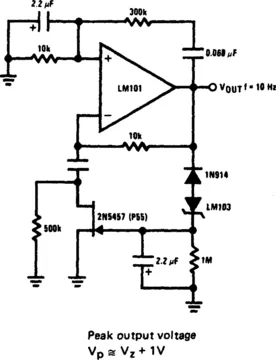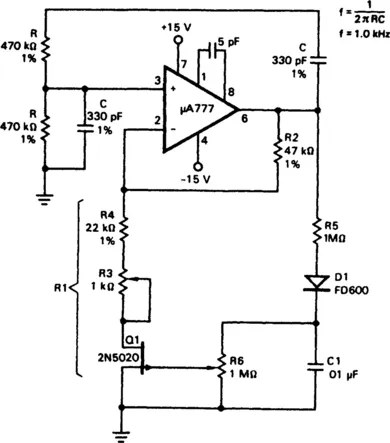
This is a test
- 192 pages
- English
- ePUB (mobile friendly)
- Available on iOS & Android
eBook - ePub
Oscillator Circuits
Book details
Book preview
Table of contents
Citations
About This Book
This series of circuits provides designers with a quick source for oscillator circuits. Why waste time paging through huge encyclopedias when you can choose the topic you need and select any of the specialized circuits sorted by application?This book in the series has 250-300 practical, ready-to-use circuit designs, with schematics and brief explanations of circuit operation. The original source for each circuit is listed in an appendix, making it easy to obtain additional information.
- Ready-to-use circuits
- Grouped by application for easy look-up
- Circuit source listings
Frequently asked questions
At the moment all of our mobile-responsive ePub books are available to download via the app. Most of our PDFs are also available to download and we're working on making the final remaining ones downloadable now. Learn more here.
Both plans give you full access to the library and all of Perlego’s features. The only differences are the price and subscription period: With the annual plan you’ll save around 30% compared to 12 months on the monthly plan.
We are an online textbook subscription service, where you can get access to an entire online library for less than the price of a single book per month. With over 1 million books across 1000+ topics, we’ve got you covered! Learn more here.
Look out for the read-aloud symbol on your next book to see if you can listen to it. The read-aloud tool reads text aloud for you, highlighting the text as it is being read. You can pause it, speed it up and slow it down. Learn more here.
Yes, you can access Oscillator Circuits by Rudolf F. Graf in PDF and/or ePUB format, as well as other popular books in Design & Industrial Design. We have over one million books available in our catalogue for you to explore.
Information
Topic
DesignSubtopic
Industrial Design1
Audio Oscillators
The sources of the following circuits are contained in the Sources section, which begins on page 173. The figure number contained in the box of each circuit correlates to the source entry in the Sources section.
Wen-Bridge Sine-Wave Oscillator
Phase-Shift Oscillator
Wien-Bridge Oscillator
Code-Practice Oscillator
Tone Encoder
Feedback Oscillator
Wien-Bridge Oscillator
Wen-Bridge Oscillator
Phase-Shift Oscillator
800-Hz Oscillator
Wien-Bridge Oscillator
Wien-Bridge Sine-Wave Oscillator
Sine-Wave Oscillator
Easily Tuned Sine-/Square-Wave Oscillator
Very-Low-Frequency Generator
Audio Oscillator
Electronic Bagpipe
Simple Audio Sine-Wave Generator
Low-Cost Wien-Bridge Oscillator
Modified UJT Relaxation Oscillator
A 555 RC Audio Oscillator
Wien-Bridge Oscillator Uses CMOS Chip
Adjustable Sine-Wave Audio Oscillator
One-IC Audio Generator
Simple Two-Tone Generator
Low-Distortion Thermally Stabilized Wien-Bridge Oscillator
Audio Oscillator
Audio Generator
Single-Supply Wien-Bridge Oscillator
Super-Low-Distortion Variable Sine-Wave Oscillator
1-kHz Oscillator
Inexpensive Oscillator is Temperature Stable
Code-Practice Oscillator
Audio Oscillator
WIEN-BRIDGE SINE-WAVE OSCILLATOR
The 2N5457 JFET, as a voltage variable resistor in the amplifier feedback loop, produces a low distortion, constant amplitude sine wave getting the amplifier loop gain just right. The LM103 zener diode provides the voltage reference for the peak sine wave amplitude.

Fig. 1-1 NATIONAL SEMICONDUCTOR
PHASE-SHIFT OSCILLATOR
Circuit uses a simple RC network to produce an exceptionally shrill tone from a miniature speaker. With the parts values shown, the circuit oscillates at a frequency of 3.6 kHz and drives a miniature 2½Π speaker at ear-piercing volume. The output waveform is a square wave with a width of 150 µs, sloping rise and fall times, and a peak-to-peak amplitude of 4.2 volts (when powered by 9 volts). Current drain of the oscillator is 90 mA at 9 volts, and total power dissipation at this voltage is 0.81 watt, which is well below the 1.25 watts the 14-pin version will absorb (at room temperature) before shutting down.

Fig. 1-2 NATIONAL SEMICONDUCTOR
WIEN-BRIDGE OSCILLATOR

Fig. 1-3 FAIRCHILD CAMERA
Field effect transistor, Q1, operates in the linear resistive region to provide automatic gain control. Because the attenuation of the RC network is one-third at the zero phase-shift oscillation frequency, the amplifier gain determined by resistor R2 and equivalent resistor R1 must be just equal to three to make up the unity-gain positive-feedback requirement needed for stable oscillation. Resistors R3 and R4 are set to approximately 1000 ohms less than the required R1 resistance. The FET dynamically provides the trimming resistance needed to make R1 one-half of the resistance of R2. The...
Table of contents
- Cover image
- Title page
- Table of Contents
- Copyright
- Other Books in this Series
- Introduction
- Chapter 1: Audio Oscillators
- Chapter 2: Crystal Oscillators
- Chapter 3: Function Generators
- Chapter 4: Miscellaneous Oscillators
- Chapter 5: Multivibrators and Square-Wave Oscillators
- Chapter 6: RF Oscillators
- Chapter 7: Sirens, Warblers and Wailers
- Chapter 8: Voltage-Controlled Oscillators
- Sources
- Index